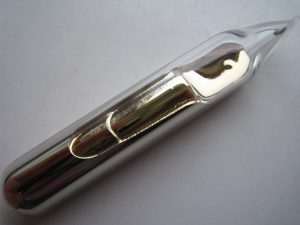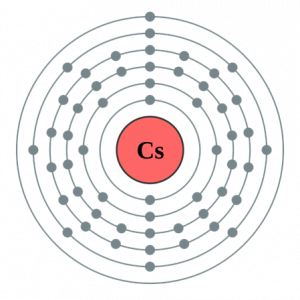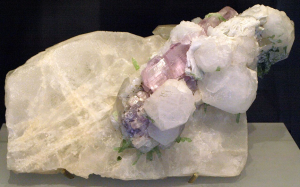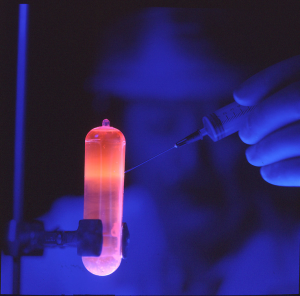Cesium
What is Cesium?
Cesium is a soft, silvery-golden alkali metal that is liquid just above room temperature. It is rare on Earth and is usually found in minerals that contain other alkali metals. Like all alkali metals, it is very reactive, and so does not exist in nature in its pure form. It only has one stable isotope and one radioactive isotope that exist in nature. Cesium is used to separate solids from liquid solutions, and in atomic clocks, international standards of measurement, and electronics. It is mildly toxic, often because it is similar in structure to essential biological elements, such as potassium.
Cesium’s Place in the Periodic Table
Cesium, an alkali metal, is found in group 1 and period 6. Other alkali metals include lithium, sodium, potassium, rubidium, cesium, and francium. Hydrogen is also in group 1 because it has one valence electron but it is not considered an alkali metal. A periodic trend in this group is that reactivity and atomic radius increase down the group. All group 1 elements react with water easily, producing hydrogen gas and strong hydroxides. Therefore, to store alkali metals, they must be protected from water in a vacuum or submerged in mineral oil. When compounds are heated to high temperatures, they can decompose into their individual atoms and release elements in their ionic and gaseous forms. This process can also produce light, and the color of the light is unique for each element. Cesium was discovered by this process, which is called flame emission spectroscopy. On burning the salts present in mineral water, cesium was identified by the production of light blue light. Therefore, it was named after the Latin word, caesius, for sky-blue.
- Atomic number: 55
- Atomic Radius: 244 picometers
- Atomic mass: 132.91
- Symbol: Cs
- Group: 1
- Period: 6
- Number of Protons: 55
- Number of Electrons: 55
- Number of Neutrons: ~ 78
- Number of Isotopes: 1 stable isotope.
Properties of Cesium

Physical Properties
Cesium is solid at room temperature and has a density similar to titanium. It melts at 1026°C, which is similar to gold. It has a boiling point of 3074°C, which is terbium. It has one of the lowest densities among the elements that are solid at room temperature.
- Melting Point: 28.5°C.
- Boiling Point: 671°C.
- Density of Solid Cesium: 873 g cm-3
- Phase at Room Temperature: solid
Chemical Properties

- Oxidation states: +1, +2
- Specific Heat: 0.24 J g-1K-1
- Electronegativity: .079 (Pauling scale)
- Heat of Fusion: 2.09 kj mol-1
- Heat of Vaporization: 63.9 kj mol-1
- Electron Configuration: [Xe] 6s1
Isotopes
Cesium only has one stable isotope, Cs-133. It makes up 100% of the cesium deposits found on Earth. It has three other natural isotopes that only exist transiently, or for a short period of time. They are Cs-134, Cs-135, Cs-137. Cs-135 has a half-life of about 2 million years. That may seem like a long time but it is very short compared to the age of Earth, which has existed 2000-times that, at about 4 billion years. Cs-134 has a half-life of 2 years, and Cs-137 has a half-life of 30 years. These are produced from the radioactive decay of fuel in nuclear reactors and atomic bombs. Thirty six other isotopes of cesium are known to science and have been observed in laboratories.
Alloys and Allotropes
Cesium can form alloys with other alkali metals, mercury, and gold. Alloys of mercury are known as amalgams. Alloys of cesium, potassium, and sodium have the lowest melting points of any alloys known (-78°C). Cesium alloys have few practical uses but can be used in atomic clocks.
Compounds of Cesium
Cesium-doped yttrium lithium fluoride is a crystal that is used to convert infrared light into visible light. Since cesium does not occur in a pure form naturally, it must be isolated from chemical compounds. Pure cesium is commonly produced from the reaction of cesium chloride with lithium. Lithium is more reactive and gives up its electron more easily than cesium, so chlorine would prefer to be bound with lithium. Therefore, in this reaction, lithium chloride is formed, which leaves behind pure cesium. It is possible to predict this outcome because lithium has a lower electronegativity than cesium.
Interesting Facts about Cesium
- Cesium hydroxide is so basic that it can eat through glass.
- Cesium for all practical purposes is the most reactive element on the periodic table. Francium is said to be the most reactive element based on the trends in the periodic table. However, francium only exists as an unstable radioactive isotope with a half-life of no more than 20 minutes. Therefore, enough francium has never been produced to test its reactivity.
- Cesium was the first element discovered using flame emission spectroscopy.
Occurrence and Abundance of Cesium
Cesium makes up .00019 % of the Earth’s crust. That is similar to beryllium and tin, and about 10-times less thgan gallium and nitrogen. In the universe as a whole, it makes up 8 x 10-8 % of the universe, which is similar to bismuth and gold. Minerals are formed when molten rock, or magma, cools. Many elements pack together and crystallize together. However, because cesium atoms are very large, they cannot fit easily into the lattice formed by other elements during solidification. Therefore, it is one of the last elements to solidify, allowing it to concentrate to form large crystals. The rocks that contain these crystals are called pegmatite, which contain minerals like pollucite (pictured). Pollucite contains large amounts of cesium. However, it is rare and only found in significant amounts in Canada, Zimbabwe, and Namibia. Pollucite also contains aluminum, silicon, and oxygen.
Uses of Cesium
Most Notable Uses in General
The devices we use to measure things every day like rulers (meters), clocks (seconds), thermometers (degrees), and scales (grams) are more complicated than you may think. All of the devices used to take accurate measurements are based on a set of universal standards that are controlled by the scientific community. These standards are objects that are housed by the International Committee for Weights and Measures stored safely in Paris, France. For example, the meter was originally defined as the distance from the equator to the North Pole as a straight line that passes through Paris. A kilogram was defined as the mass of one liter of pure water. What about time, you ask? A second is defined as the amount of time that it takes for a specific amount of radiation to be produced by caesium-133. That is why cesium is used in atomic clocks and electronic devices, such as cell phones, to measure time.
Most Notable Uses in Science
Solutions are made of chemicals that are dissolved into individual atoms, ions, or molecules. However, when insoluble, solid particles are added to liquid, it does not form a solution but a mixture or suspension. When the solid particles are small and have a similar density to the liquid where they are suspended, they can be difficult to separate. Cesium ions create solutions that are 4 times the density of water, and so can sink to the bottom of a test tube that contains a mixture of suspended particles in water. To separate the solid from the water, the test tube can then be placed in a centrifuge, where it spins rapidly in a circle, creating a centripetal force that pulls the solid out of the mixture with water. If the solid is less dense than the cesium ion solution, the solid will concentrate and form a layer between the water and cesium chloride solution. This process is known as density centrifugation, and it is used in laboratories to isolate solid precipitates of DNA that is extracted from cells using alcohol (layer of DNA pictured in fluorescent orange)
Discovery of Cesium
Cesium was discovered by Robert Bunsen (yes, Bunsen of the Bunsen burner) and Gustav Kirchhoff in 1860. They used flame emission spectroscopy (explained in Section 2) to identify elements in mineral water from Dürkheim, Germany. They were able to obtain a pure sample by evaporating 44,000 liters of water.
Cesium in the Future
Crystals of caesium, lead, and iodine are being researched for their use in solar cells to produce electricity from light. Solar cells that contain cesium can be thinner and constructed with cheaper materials than other types of solar cells. As research continues, cesium-based solar cells have improved in their efficiency from 3% to 20%, which is a measure of how many photons of light that strike the solar cell are used to produce electricity.

